Or – “More Evidence That Revamps Are Hardly A New Development…”
I find it interesting that, of all the heroes of the 1940s-era, Plastic Man seems to be the one destined to have children. Fans of the 1970’s Plastic Man cartoon will recall his adventures with Baby Plas, while Kingdom Come featured his son as the hero called Offspring. A memorable JLA story featured his illegitimate son from a youthful indiscretion (who later became a Teen Titan, also calling himself Offspring, because Alex Ross apparently needs royalties.) But, have you ever wondered where all this Plastic Dad business kicked off?
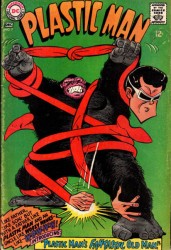 PLASTIC MAN #7
PLASTIC MAN #7
Writer: Arnold Drake
Penciler: Win Mortimer
Inker: Win Mortimer
Cover Artist(s): Carmine Infantino & Mike Esposito
Colorist: Uncredited
Letterer: Uncredited
Editor: Murray Boltinoff
Publisher: DC Comics
Cover Price: 12 Cents
Current Near-Mint Pricing: $45.00
Previously, in Plastic Man: Eel O’Brien comes from a strong pedigree, the creation of Jack Cole, who by 1941 was already a respected artist, writer and editor who did notable work on characters including MLJ’s The Comet and Lev Gleason Publications’ Daredevil before creating Plas. When Quality Comics folded in the mid-50’s, their properties were sold to National Periodical Publications (known as DC Comics, these days) and Plas was put on the shelf with the rest of the Quality bunch. It was a full decade before Plastic Man appeared in a legally published comic book (a few reprints eked out from Super Comics, but they probably don’t count), and when he did, it was as one of the alter-egos of Robby Reed in ‘Dial H For Hero.’ Later that same year, Plastic Man returned in solo adventures of his own, with a new costume, attitude and sidekick in the form of Gordon K. Trueblood, a square peg in all senses of the word. How in the world did this happen? Where’s Woozy Winks? What’s the deal with airline food? Fear not, Faithful Spoilerite, all shall be answered forthwith (except the bit about the airline food, for which answer you need to send a postage paid envelope to: J. Seinfeld, General Delivery, New York, NY 10001.) We open in media res, as a group of villains raids a local art gallery, only to run afoul of a familiar looking pair of stretchy fists…

Come the next morning, Gordy berates Plastic Man for failing to bring in the villains (he got taken down by a smoke bomb, allowing the villains to escape) when Plastic Man reveals the truth: He wasn’t present at the gallery robbery. It was… Dum DUM DUMM! His father! (Were you surprised? Given that I spoilered it up top, I doubt it, but I still enjoy building a little tension where I can…)

This is a reasonably accurate retelling of the original Quality Comics origin of Eel O’Brien, although I don’t recall Plas talking “square” as PM Jr. does. Those of you with sharp eyes will recall that this is issue #7 of the relaunched Plastic Man title, and circa 1966 there was no such thing as Wikipedia to clear up any questions you might have about what the blue hell is going on with a certain comic book. The letters page of this issue refers to the editors getting TONS of mail from the first issue of this book asking DC to explain how this new Plastic Man might relate to the old one, this in the earliest years of the Earth-One/Earth-Two/Earth-Fifty-Three delineations. I want to think that making this P.M. the son of the genuine article was a decision made from day one, but I kind of prefer the idea that they were so overwhelmed with mail that they forced the writer to come up with an explanation to shush the roars from fandom. In any case, Plas continues telling Gordy his life story…
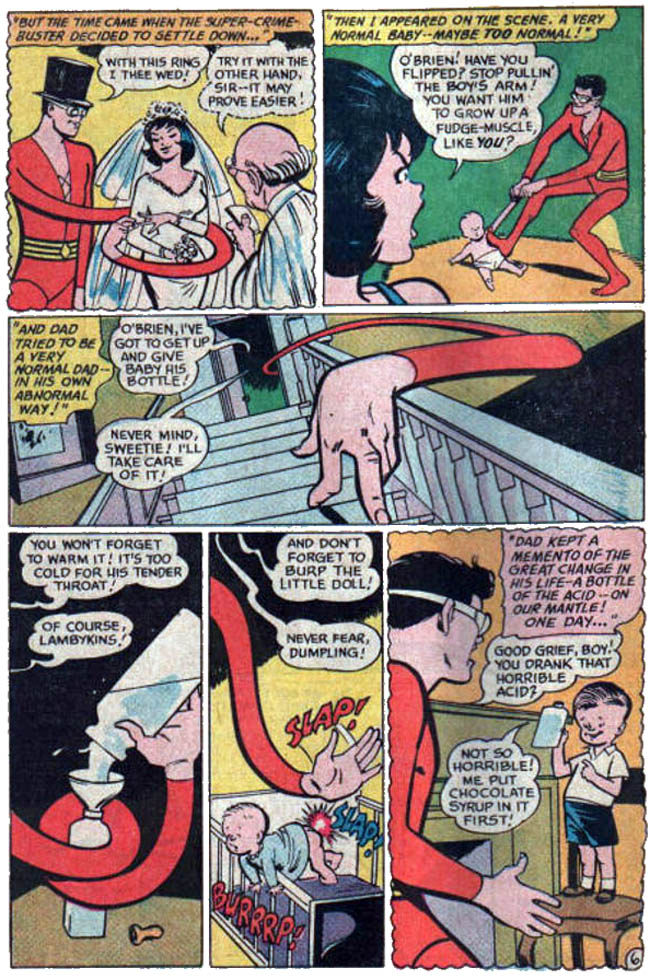
Okay, bits of explanation here: For some reason, all children in Silver Age DC Comics talk like Baby Plas does in that final panel (“Me no like this! Me use me super-powers to kill all humans!”) There is, however, no rational explanation for Eel keeping a bottle of ACID on the mantlepiece of his familial retreat, especially with a little one in the house. Except, of course, for the obvious conclusion to which I have come: EEL O’BRIEN WANTED HIS SON TO DRINK THE ACID!
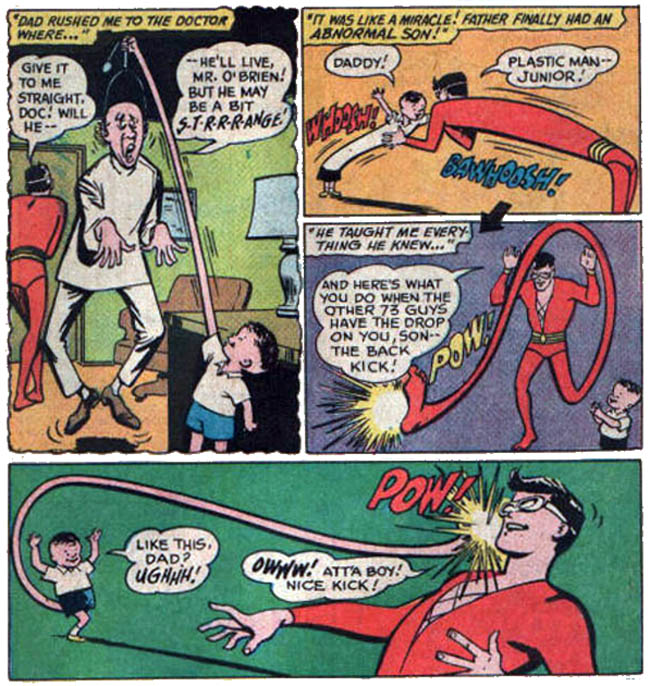
Honestly, if they were to retell that story today, the only way to make it work is to play that oh-so-very-Grant-Morrison angle up. More fun than the maybe-not-so-accidental poisoning of a toddler, though, is the sight of Woozy Winks and Eel O’Brien as the proprietors and managers of Plastic Acres Retirement Community, where there is LITERALLY something in the water!
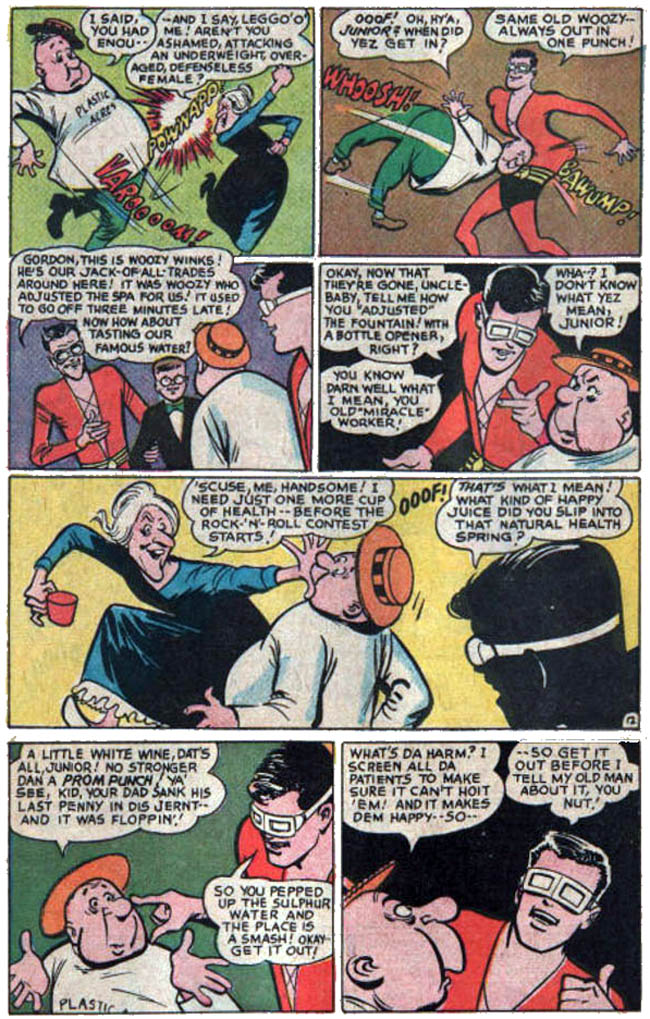
How do you follow up feeding chemical compounds to the wee ones? Why, by getting a condo full of octogenarians drunk off their @$$, that’s how. Say what you will about Arnold Drake, the man knew how to write a good time. (Given that his most famous creations are the much-more-depressing Deadman and Doom Patrol, it’s nice to see Drake cutting loose with a little bit of humor.) As for the villains from the beginning of the issue, it seems that they are trying to steal Plastic Acres away from Eel (apparently seeking the secret of the health elixir in the spa), leading the foursome to set off on a complex mission that involves a pink and red camel and Gordon Trueblood in surprisingly effective drag…
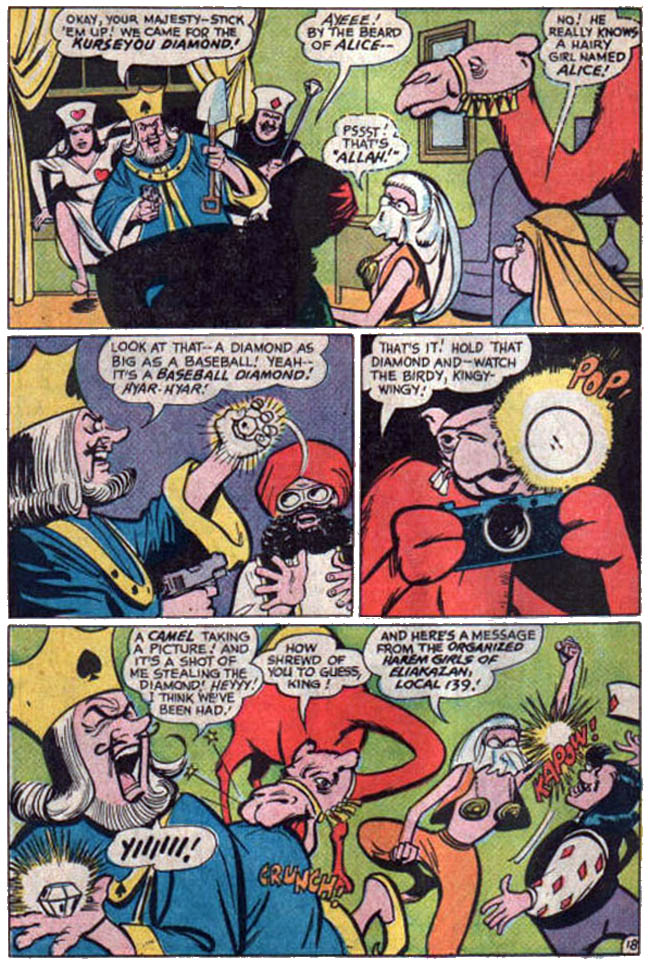
The line about Gordy talking like Plas’ father is played for laughs here, as the morally flexible Woozy bonds with Plas Junior, while straight-arrow Gordy and old-school Plastic Man find a common ground in their law-abiding ways. Young Plas and Gordy get pictures of the king involved in criminal activity, but the film gets exposed by accident, causing the young hero to give up. This does NOT sit well with the plasticine pater familias! Cue the vintage 1940’s butt-kicking, Marx Brothers-style…
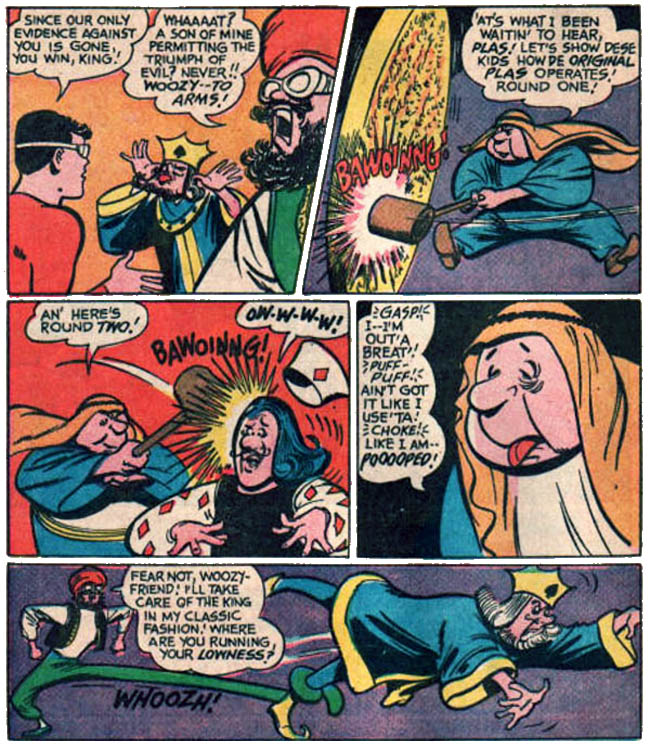
Seeing the old man in action, Young Plastic Man realizes that a real hero never gives up, and quickly uses his wits to scam the scammer. Pretending to give in the King’s demands, he promises to turn over Plastic Acres to the fiend… AFTER they have a sip or two from Woozy’s special fountain to celebrate, y’all.
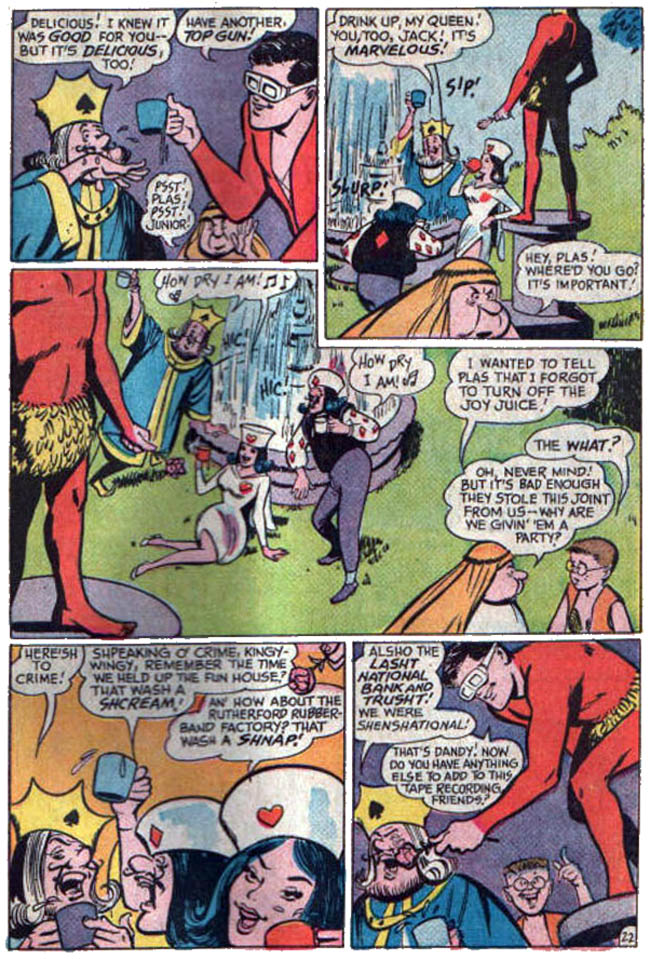
BAM! PLASTICKED! The King’s admission of illegal activity is recorded by a tape recorder hidden in Plastic Man Junior’s rose, and the issue ends with the heroes celebrating as the unconscious villains sleep off their hangovers in the background. Interestingly, the issue is dedicated to Marv Wolfman, future Marvel Comics editor-in-chief, creator of the New Teen Titans and all-around comics guru, who was at the time of publication still two years away from breaking into comics as a professional. (This also adds to my “Oh, god, we have to fix this or the fans will $#@&ing kill us!” theory.) This entire series is an odd bit of DC ephemera, a book that mostly nobody remembers. According to the wiki, someone has claimed that this book takes place on an alternate Earth of the multiverse (reportedly Earth-12, also home to the Inferior Five, another Silver Age fave-rave of mine), though I can find no documentation of this particular claim.
It is also worth noting that this particular issue holds a place in Major Spoilers history as well, as the very first Retro Review that I ever WANTED to do for the site. The first R.R. was born of desperation and a sparse comic delivery week, but I found myself enjoying the review of a random issue of Master Of Kung-Fu enough to want to try again, and went to find this comic in my collection, only to find that I no longer owned it, somehow. I blame elves, honestly. That second Retro Review actually covers a little bit of the same territory as this one, but it’s been nearly five years since then, and I figured enough time had passed that we could get back to the adventures of the Plastic Man who knew too much, and who disappeared far too soon. Consider this a late celebration of my Major Spoilers fifth anniversary (which was approximately 90 days ago, on par with most of my timing in 2011) and a little gift for the Plastic fans in the audience. Plastic Man #7 is Silver Age storytelling fun at it’s best, with a little Bronze Age retcon-fixing thrown in, making it the best of two separate worlds, earning a stone-cold 4 out of 5 stars overall.
Faithful Spoilerite Question Of The Day: Anybody want to hazard a guess as to why there’s a gorilla on the cover, even though there are no gorillas anywhere in the book (or indeed anywhere in this SERIES?)



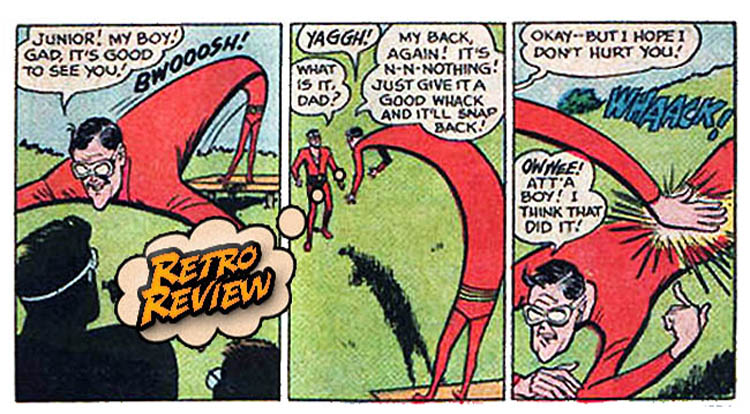
5 Comments
How did his costume change? It looks the same there as always.
So funny about the toddler-speak. I was thinking the exact same thing when I read the panel. Reminded me of all the horrible super-baby babble.
Would have been funny if they tied the villains back to the Royal Flush Gang somehow.
How did his costume change? It looks the same there as always.
Young Plas had long pants and black trunks, while Papa Plastic Man has been given the long pants as well. In the Golden Age, he appeared bare-legged and usually barefoot (or at least with skin-tone plastic feet.)
Anybody want to hazard a guess as to why there’s a gorilla on the cover, even though there are no gorillas anywhere in the book (or indeed anywhere in this SERIES?)
Gorillas are newstand gold? That seemed to be a genuine philosophy in the Silver Age.
I think a lot of people just think Plastic Man would make a cool dad. It’s also a way to make the character seem less “silly” & more responsible without robbing him of his sense of humor. It’s a better to do that than, say, forcing him to take a Batman route of being broody all the time.
Gorillas are newstand gold? That seemed to be a genuine philosophy in the Silver Age.
Correctamundo, pumpkin, and that makes us two little Fonzies… That cover being drawn by Carmine Infantino always made me think this issue featured Plastic Man in battle with Gorilla Grodd, foreshadowing the Brave & The Bold cartoon, but in fact it’s something entirely different. It seems that cover stunts (like the recent Wolverine tributes or the Iron Man movie covers on non-Iron Man related books) aren’t a new development, either.
Loved Plastic Man. Morrison made me so happy when he included him into the JLA.
Sadly, gorillas were a DC staple in the silver age, just like mutants were in Marvel books in the 80’s.